Journal
of Combative Sport, July 2010
Boxing Gloves of the Ancient World
Copyright © Steven Ross Murray 2010. All rights reserved.
Boxing has a long,
storied history. Its origins can be traced as far back as ancient
Mesopotamia, where a terracotta relief was discovered that depicts
men boxing (Figure 1). Surely, though, boxing is much older, given
the fact that the act of striking another with one's fist is simply a
basic defensive (as well as offensive) mechanism for survival.
Little imagination is necessary to envision how the rudimentary
nature of striking could evolve into training activities for hunting
and warfare, and, eventually, into an organized sport such as boxing.
With any sport's development, however, the use of specialized
equipment occurs, and the equipment, too, begins to evolve over time.
The literary and archaeological evidence, left by the ancients,
provides much detail about boxing in antiquity, especially the type
of equipment, particularly the glove (or lack thereof), that was
used. The purpose of this paper is to describe the development of
the boxing glove in the ancient world, summarizing the major types of
gloves used.
|
Figure 1.
Terracotta plaque of wrestlers and boxers. Khafaji, Nintu Temple,
Early dynastic Period, 3000-2340 B.C.E., Iraq Museum, Baghdad.
Source: Flickr at
www.flickr.com/photos/pankration (Pankration Research Institute's
photostream; used with permission).
|
Mesopotamia, Egypt, and
the Minoan and Mycenaean Civilizations
One of the earliest
depictions of boxing in antiquity appears in a relief, found in
Eshnunna (modern-day Tell Asram, Iraq), of two Mesopotamians from the
early third or second millennium B.C.E.,
(Figure 2). The two boxers, sporting beards and wearing tunics, are
facing each other with their arms bent and fists clinched; each is
ready to deliver or to defend a blow. Neither is wearing gloves, but
both are fitted with some type of band worn around the wrist,
presumably for anatomical support. Another terracotta tablet, c.
1200 B.C.E., found in a tomb
at Sinkara (modern-day Tell as-Senkereh, Iraq) pictures two men
presumptively boxing to musical accompaniment, but that conclusion is
open to interpretation (Figure 3) [EN1]. Both men are wearing caps and
tunics, but neither is wearing boxing gloves. If these men, indeed,
are boxing, they are doing so bare fisted.

Figure 2. Terracotta relief of two Mesopotamian boxers, c. 2000 B.C.E. from Eshnunna, (Modern-day Tell Asram, Iraq).
Source: Erich Lessing / Art Resource, NY; used with permission.
|

Figure 3. Terracotta relief depicting two men boxing to musical
accompaniment, c. 1200 B.C.E., Sinkara (modern-day Tell as Senkereh, Iraq).
Source: Flickr at www.flickr.com/photos/pankration (Pankration Research
Institute's photostream; used with permission).
|
Egyptian boxers, too,
seemed to fight bare fisted, as a relief from Thebes, c. 1350 B.C.E.,
shows
three pairs of men directly squaring off in boxing matches (Figure
4). The men are clothed only in loincloths. The event being
chronicled seems to be important, as the men are purportedly
performing for the pharaoh [EN2]. Oddly, one man in the third pair of
boxers from the left, seems to be throwing punches simultaneously
with both hands while his adversary uses his forearm to block them.
The awkward stance of the punch-throwing boxer has some scholars
suggesting that these men are actually dancers, but their
juxtaposition beside two men stick fighting refutes this
interpretation [EN3]. Moreover, the hieroglyphics on the relief next to
the boxers have been translated to read as “Hit!,” “Hit, hit!,”
and “You have no opponent,” thus removing all doubt that these
men are boxers [EN4].

Figure 4. Egyptian boxers and stick fighters, c. 1350 B.C.E., from the Tomb of Kheruef, Thebes, Egypt.
Source: Courtesy of the Oriental Institute of The University of Chicago, used with permission.
|
The Minoans seem to be
the first civilization to employ the use of boxing gloves. A relief
on a drinking vessel called the “Boxer Vase” from Hagia Triada,
c. 1500 B.C.E., depicts
several scenes of combative or ceremonial activities (Figure 5). The
conical rhyton, made
of black soapstone, is
decorated with four sections of reliefs. The top level of the vase
is decorated with five men, of whom two are directly engaging in a
fist fight; one is throwing a punch to his opponent's head while the
other is countering with a body shot. The three other boxers—if
they are, in fact, boxers, seem to be watching the other two in
action, as they are facing the same direction, with one kneeling, as
if to give the other two a better view; all are separated from the
two fighting figures by a column. The second section pictures two
bulls running, with one having gored a man—who is still attached to
the bull's horn—and most definitely signifies some homage to the
extremely dangerous, yet seemingly ubiquitous, activity of
bull-leaping [EN5]. The third section represents several boxers.
Although the original vase has suffered extensive damage, the men
pictured seem to be equipped with an object covering the back of
their hands, starting at the wrist, but secured with some kind of
strap. Unlike modern boxing gloves—which are padded to provide
protection for the small bones in the hand as well as for the
combatant who is receiving the blow—these objects seem to be
designed to produce extensive damage to one's opponent. The artist's
depiction of the boxers wearing helmets and arm guards speaks to the
potential brutality of the activity being portrayed, and it
reinforces the idea that these boxing “gloves” are primarily an
offensive weapon designed to inflict physical damage through blunt
force, as there is no sign that a sharpened edge is being employed.
We have no way of knowing the rules of this activity, and we cannot
tell definitively if these men are fighting mano
a mano or on teams. Nevertheless, it is
clear that these men are engaged in some kind of contest or ceremony.
The bottom level of the vase has a number of men engaged in a
combative event of some sort, but again, we have no idea of the
specific rules or the intended purpose of the activity. Several of
the men seem to be holding knives and possibly using them against
other men, who are lying on their backs or sitting on their buttocks
and attempting to kick up at their respective adversaries. The scene
is so perplexing that some scholars even have labeled the combatants
as wrestlers [EN6], but I definitely would not classify them that way,
even with the broadest of interpretations. It seems, to me, that the
pictured combatants are caricatures of either some sort of
militaristic training or an elaborate pictorial of what we, today,
would call a knife fight.

Figure 5. “Boxer Vase” from Hagia Triada and drawing, c. 1500 B.C.E.
Source: Flickr at www.flickr.com/photos/pankration (Pankration Research Institute's
photostream; used with permission).
|

Figure 6. The “Boxing Boys,” fresco from Thera (modern-day Santorini), c.
1600 B.C.E.
Source: The Thera Foundation at www.therafoundation.org/ akrotiri/buildingbeta/boxingboysroombeta1southwall/view.
|
Probably the most famous
evidence for Minoan boxing is a fresco from the island of Thera
(modern-day Santorini) at Akrotiri, c. 1600 B.C.E.,
aptly called the “Boxing Boys” (Figure 6)
[EN7]. Two boys are shown boxing [EN8]. Interestingly, both are wearing
only one glove on the right hand, but the damage to the fresco is too
extensive to draw any real conclusion as to the makeup and
construction of the glove. All that can be ascertained positively is
that the glove extended proximally, from the wrist, roughly one-third
up the forearm and that it was attached by some type of band,
presumably fabric or leather. The covering of the fist itself is
lost to antiquity, but the artist who filled in the fresco imagined
that the glove was enclosed and of cylindrical shape. We have no way
of knowing if the glove had open fingers, as one gloved hand is too
damaged (but a small section of the fresco suggests that the glove
may have been enclosed), and the other is occluded by one
participant's head.

Figure 7. Mycenaean amphora shard depicting two boxers, c. 1300 B.C.E.
Source: Flickr at www.flickr.com/photos/pankration (Pankration Research
Institute's photostream; used with permission).
|
A fragmented Mycenaean
amphora, c. 1300 B.C.E.,
pictures what must be two boxers preparing for competition (Figure
7). Both combatants are facing each other in the traditional
athletic position, with legs bent, readying each participant for
quick, evasive movements. The only truly odd feature of the artwork
is that the two combatants are pictured with both arms
outstretched—which is pragmatically curious, but probably just a
result of artistic license—as outstretched arms would be rather
inefficient in a skilled, boxing match. In all likelihood, however,
the men pictured on this pottery shard are boxers, as their hands are
most definitely covered in some sort of boxing glove. Unfortunately,
the artistic rendering is simply too vague to provide us with the
specific details of the physical makeup of the boxing gloves.

Figure 8. Boxer surrendering by raising one finger, Greek amphora painting, c. 500 B.C.E.
Source: Flickr at www.flickr.com/ photos/pankration (Pankration Research Institute's photostream; used with permission).
|
Ancient Greece
The era for which we have
ample information to draw numerous conclusions about boxing and its
concomitant equipment is ancient Greece. The ancient Greeks left us
numerous inscriptions, literary references, and a myriad of
sculptures and amphorae to understand a great deal about ancient
boxing (pyx).
We can summarize the
essence of ancient Greek boxing with the following inscription from
from the first century B.C.E.:
A boxer's
victory is gained in blood [
EN9].
A modern-day boxer would
be horrified by the rules on ancient Greek boxing. A boxing bout
involved no weight classes and no rounds—and thus no mandatory
breaks—and to win a boxer must either knock out his opponent or
force him to submit; one would signal capitulation ad
digitum by raising a single finger (Figure
8). The bouts were generally fought in a softened, dirt pit
(skamma), with an
official overseeing the contests. It is interesting to note that the
officials supervising the boxing carried a long, forked switch that
they would use to whip any athlete who violated the rules. The rules
were fairly simple and straightforward: no clinching, scratching, or
biting [EN10]. Other than that, it was essentially a free for all, but
scholars still debate if kicking were allowed [EN11].
To say these boxing
matches were gentlemanly contest would be completely wrong; these
fights were for glory and immortality, especially if they were at one
of the crown games such as those held at Olympia. However, to
characterize boxing as an event for a mindless thug would be
incorrect. A boxer had to be highly trained, well-conditioned, and
extremely skillful. Poliakoff [EN12] writes:
To say that victory in ancient boxing depended on
brutality alone would be a great exaggeration, for the sport required
a high degree of skill and strategy in addition to courage and
fortitude.
An interesting note about
Greek boxing, as was with most sport in ancient Greece, is that the
athletes competed in the nude. The only article of “clothing”
that the Greek boxers typically would wear would be their boxing
“gloves.”
Greek boxing gloves were
termed himantes (singular:
himas), and they were modified over time.
The first Greek boxing gloves, called “thongs” (ίμάντες),
were nothing more than tanned, leather straps—estimated to be
roughly four meters in length [EN13]—which were wrapped around the
wrists and hands in deliberate and intricate fashions (Figure 9).
There seems to be little consistency in how the boxers fitted their
hands with the thongs, though. Some would wrap their wrists and
hands completely, creating what the ancients described as something
club-like (Figure 10).
Boxers'
himantes of leather
were wrapped around their hands to make them better for striking and
to hold the fingers together, binding them stiffly into a round
shape, like some sort of club [
EN14].

Figure 9. Greek boxer applying his “soft thongs” to his hand and wrist, 520-500 B.C.E.
Source: Flickr at www.flickr.com/photos/pankration
(Pankration Research Institute's photostream; used with permission).
|
Not every fighter wrapped
his entire wrists and hands. Some used the thongs simply as braces
for the wrists; while others would even leave a single hand
completely unwrapped (Figure 11). It seems, then, that the primary
purposes for the thongs were to support the wrists and to provide
some modest protection for the knuckles and the fingers. These facts
suggest that the thongs were designed to be a defensive, and not an
offensive, weapon. Nonetheless, it is clear that a secondary purpose
of the thongs was to increase the severity of a blow, by cutting in
to the skin of an opponent, and causing him to bleed. The noted
professor of classics, Dr. Thomas Scanlon, states:
They
wound leather straps, of rawhide leather, around their fists and up
their arms, in order to increase the violence of the blow itself.
The leather would actually cut in to the skin of the opponent. They
would very often land a blow in the head, and there would be blood
dripping all over, and they would fight on and on [
EN15].
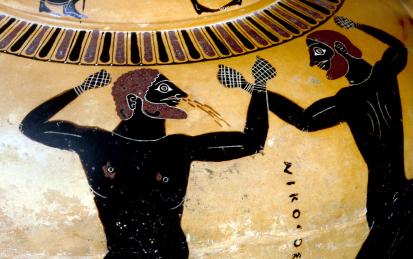
Figure
10. Greek boxers with “soft thongs” wrapped completely around both
fists and wrists, c. 520-510 B.C.E. Source: © The Trustees of the
BritishMuseum, used with permission.
|
A perfect example of the
damage that these leather straps could inflict is shown on ancient
vase paintings (Figure 12). In the figure, the boxer on the right
has several cuts on his left cheek, with blood flowing from them and
down his face. It is obvious that the thongs increased the severity
of a blow [EN16], and, without doubt, provided a useful, offensive
weapon. In addition to the graphical examples of the potential
damage that could be inflicted with the thongs, literary evidence,
too, suggests that injuries to boxers were frequent and, often, quite
severe.
O
Augustus, this man Olympikos, as he now appears, used to have nose,
chin, forehead, ears, and eyelids. But then he enrolled in the guild
of boxers, with the result that he did not receive his share of his
inheritance in a will. For in the lawsuit about the will his brother
shows the judge a portrait of Olympikos, who was judged to be an
imposter, bearing no resemblance to his own picture [
EN17].

Figure
11. Black figure amphora depicting two boxers with “soft thong” applied
to only one hand, c. 500 B.C.E. Source: Flickr at
www.flickr.com/photos/pankration
(Pankration Research Institute's photostream; used with permission).
|
An added benefit of the
thongs is that they allowed an ancient boxer to open and to close his
fist at will, thus permitting him to use his hands more as defensive
weapons: The boxer could reach out and try to catch or simply to
block an incoming punch with his open hand. This technique is shown
in vase paintings, leading one to think that it would be a
legitimately successful tactic (Figure 13). Perhaps the best example
of how a boxer used the ability to open and to close his fist freely
is the example of Demoxenos of Syracuse. Pausanias writes:
And I
know a similar story about what the judges of Argos did in the case
of Kreugas from Epidamnos in boxing. For the Argos judges gave the
prize of Nemea to Kreugas although he was dead, because his opponent,
a Syracusan named Damoxenos, broke the special rules which the two
athletes had agreed upon. For darkness was about to occur as they
were fighting, and they agreed in the presence of the judges that
each would submit to one blow from the other. The fighters in those
days did not have the “sharp gloves,” extending up the wrists on
both hands but they were fighting with the “soft gloves” with
slim strips of rawhide from an ox, and they were crisscross around
the hands in the old-fashioned manner. Well then, Kreugas struck his
opponent on the face; Damoxenos then told Kreugas to raise his arm to
protect his head, and when Kreugas did this, Damoxenos struck him
under the ribcage with fingers stiff. Because of the pointed fingers
and the force of the blow he drove his arm into the abdominal cavity
of his opponent, seized the entrails, and tore them out. Kreugas
expired on the spot, and the Argive judges disqualified Damoxenos
because he had not followed the agreement, since instead of one blow
he had used several against his opponent. They gave the victory to
the deceased Kreugas and set up a statute in Argos, which in my day
was located in the sanctuary of Lycian Apollo [
EN18].

Figure 12. Particular of black figure cup showing boxer's face cut by “soft
thongs,” c. 409 B.C.E. Source: Flickr at www.flickr.com/photos/pankration
(Pankration Research Institute's photostream; used with permission).
|
Irrespective of the
possible embellishment here by Pausanias, it is fair to say, I think,
that the ability to open and to close one's hand freely during a
fight would affect the various techniques involved in the bouts,
especially compared to a modern-day boxer. I would suspect some of
the techniques employed in antiquity were similar to the fighting
styles of today's mixed martial artists, particularly their stand-up,
striking skills. It is important to note that the gloves used in
mixed martial arts today are relatively thin, with modest padding,
and allow the fighter to open and to close his hands with minimal
restrictions. I would submit that history, once again, repeats
itself, even though modern, mixed martial arts are more like the
ancient pankration [EN19]
than ancient boxing. The initial Greek thongs were used from the
eighth to the fourth century B.C.E., yet later became known as “soft
thongs” (μειλίχαι) [EN20].

Figure 13. Amphora depicting two boxers fighting with open hands, c. 500
B.C.E. Source: Flickr at www.flickr.com/photos/pankration (Pankration
Research Institute's photostream; used with permission).
|
Excessive sparring with
thongs would be painful and, potentially, a career-ending experience.
So, the ancient Greeks developed a practice glove called sphairai
or episphairai
(Figure 14). These gloves were designed to allow boxers to practice
at full speed, yet to reduce substantially the chances of injury.
Plato describes the purpose of sphairai
thus:
In order to imitate as nearly as possible the fighting in the
ring...we would put on sphairai
so that we could practice striking and the avoidance of blows as much
as possible [
EN21].
Plutarch goes so far as to
describe the blows received from these training gloves as “painless.”
For
in the palaestra they put episphairai
on the hands of the competitors, so that the bout may not have any
serious consequences, since the blows are soft and painless [
EN22].
While probably an
exaggeration on Plutarch's part, compared to the thongs, the training
gloves must have seemed like feather pillows.

Figure 14. Terracotta boxing caricature wearing padded, training gloves (sphairai).
Source: Flickr at www.flickr.com/photos/pankration (Pankration Research Institute's photostream; used with permission).
|
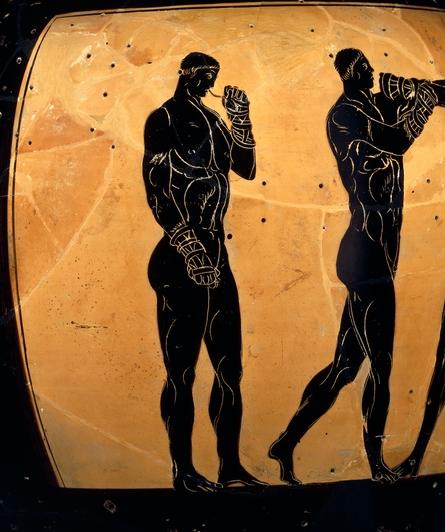
Figure
15. Greek black figure amphora depicting a boxer adjusting his “softer
thongs” with his teeth, waiting for his next bout, c. 336 B.C.E.
Source: © TheTrustees of the British Museum, used with permission.
|
A more cushioned,
competitive glove (σφαίραι) was developed during the fourth
century B.C.E. that was later
termed “softer thongs” (ίμάντες μαλαχώτεροι)
(Figure 15) [EN23]. These thongs were constructed by using a fleece
under-layer—which made the gloves much softer—and it was secured
to the forearms, wrists, and hands by leather straps. Note that the
boxer in the figure is adjusting his thong by pulling on one of the
leather bands with his teeth, apparently for an upcoming fight.
These softer thongs must have been heavenly compared to the original
thongs, but the reprieve was short lived. The softer thongs,
ultimately, served as a precursor to an even more destructive glove,
the “sharp thongs” (ίμάυτες), which were developed by
adding a hardened piece of leather, serving as a cutting piece, that
was interlaced with the other leather bands and placed across the
knuckles of the fingers. It was some sort of primitive
knuckleduster, and the sharp thongs replaced the softer thongs by the
third century B.C.E. [EN24]
One suspected reason for the change to the sharp thongs is simply for
added brutality, so the excitement at the games could be enhanced and
thus the crowd more easily placated. We must remember that it was
during this period that the stadia at each of the sites for the
Panhellenic games were enlarged and remodeled, so “the added danger
of the cutting thongs may have been somewhat a crowd-pleasing
attraction” [EN25]. Eventually, the sharp thong developed into a
true glove, being much easier to put on and to remove, and had
interwoven leather straps, securing the leather knuckleduster so that
it would not shift on the hand while a boxer was delivering a blow.
An excellent representation of the sharp thongs can be seen in the
bronze statue of the Terme Boxer, c. first century B.C.E.
(Figure 16). A close examination of the statue's
face shows the destructive power of the sharp thongs. It appears the
boxer has a broken nose and numerous cuts on his face and ears, with
the accompanying swelling one would expect to see. The injurious
nature of the thongs led to them earning an interesting nickname,
myrmikes (ants), as it
is believed, by some, to be a metaphorical reference that the thongs
caused pock-marks and pain, much the way ants do when they burrow or
sting [EN26]. Scanlon, however, believes that, “[d]uring the
Imperial period the sharp thongs acquired the additional popular and
humorous name “the ants” (μΰρμηκες) originally on account
of their appearance” [EN27]—the enlarged fist being similar in
shape to an ant's head, with the wrist and forearm resembling the
tapered abdomen of an ant. Regardless of how the thongs earned their
popular and ubiquitous moniker, they most definitely were physically
destructive. One only needs to note the “cauliflower ears” of
the Terme Boxer—and the artist's special attention to detail,
showing the cuts in the ear and how they surely would have bled—to
be convinced of the thong's destructive ability. The Terme Boxer
leaves no doubt that the sport of boxing in ancient Greece was brutal
and bloody, verifying the ancient quote, “A boxer's victory is
gained in blood.”
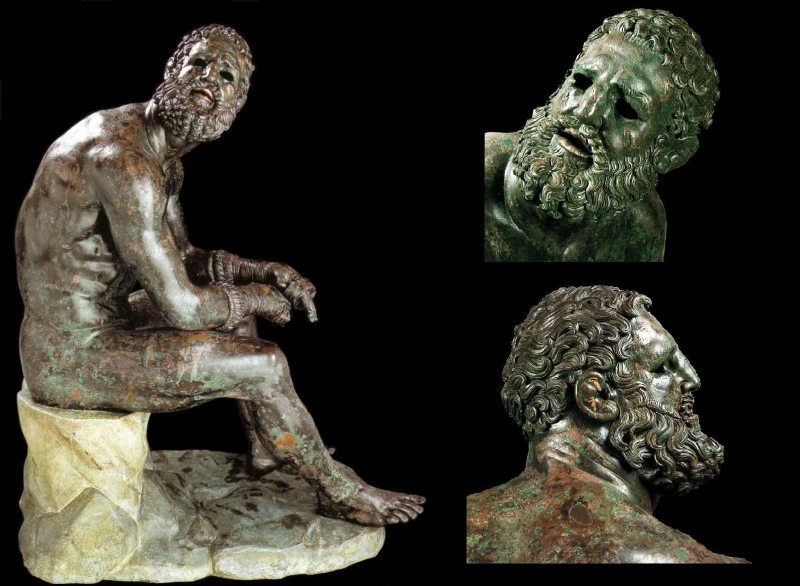
Figure
16. Bronze statue of a seated boxer (“Terme Boxer”), 2nd or 1st century
B.C.E., The National Museum of Rome. A composite of several images
available at Flickr at www.flickr.com/photos/pankration (Pankration
ResearchInstitute's photostream; used with permission).
|
Ancient Rome
Greek boxing was, indeed,
brutal, but it paled in comparison to the boxing (pugilatus)
of the Romans. Initially, the Romans incorporated the sharp thongs
of the Greeks for their boxers (figure 17), but they soon modified
the sharp thongs, by replacing the leather knuckleduster with a metal
insert, forming a glove known as a caestus
(Figure 18) [EN28]. The Roman caestus
was nothing less than a true, murderous weapon [EN29]. Scanlon states:
So it
was almost more like a knife fight than a boxing match. There were
very short careers, and there were people who were very successful,
and then a lot of newcomers who kept getting stabbed, or actually,
ruptured by the gloves [
EN30].
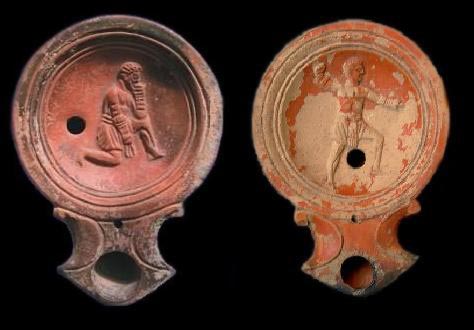
Figure 17. Two terracotta oil lamps depicting Roman boxers equipped with “sharp thongs,” c. 1st century C.E.
Source: Flickr at www.flickr.com/photos/pankration (Pankration Research Institute's photostream; used with permission).
|
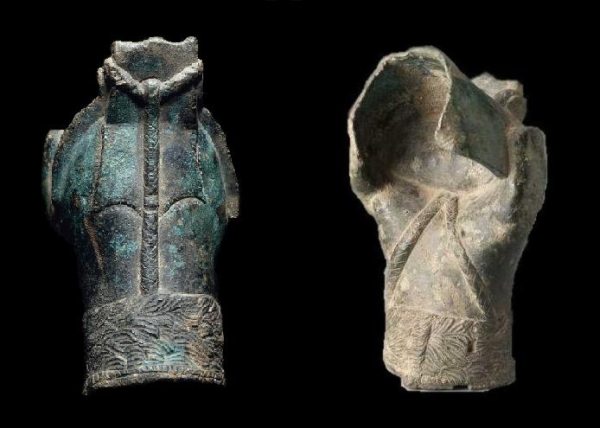
Figure
18. The Romans modified the Greek's “sharp thongs” by replacing the
leather knuckleduster with metal inserts, forming the caestus, a truly
dangerous weapon, c. 150 C.E.
Source: Flickr at www.flickr.com/photos/pankration (Pankration Research Institute's photostream; used with permission).
|
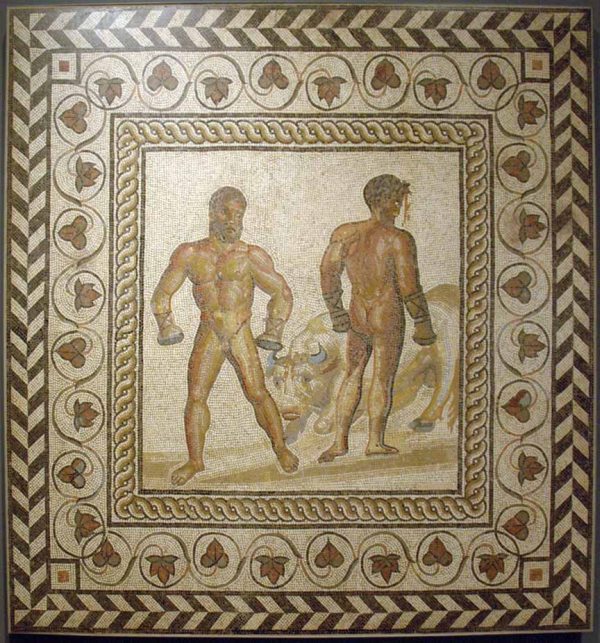
Figure
19. Mosaic depicting the famed match between Entellus and Dares of
Virgil's Aeneid. Source: Flickr at
www.flickr.com/photos/pankration(Pankration Research Institute's
photostream; used with permission).
|
Virgil references the
brutal nature of the caestus
in his fictional Aeneid [EN31].
He tells us of the Sicilian boxer named Entellus, who intended to
fight with a pair of metal-laden gloves that previously had been used
by his brother Eryx, evident by the fact that they were still
“stained with blood and splattered brains” (sanguine
cernis adhuc sparsoque infecta cerebro) [EN32].
His opponent, the Trojan, Dares, refused to fight until smaller,
lighter gloves were used, so the sponsor of the match, Aeneas,
complied with Dares's request. Entellus went on to win the fight and
the spoil of victory: a bull. Entellus further demonstrated just
how destructive the caestus
could be, even the smaller, lighter ones, by using his right hand to
deliver one blow to the bull's head, killing it by fracturing its
skull. Virgil's story was forever immortalized in a mosaic,
depicting the victorious Entellus, with his wounded opponent and
dying bull (Figure 19). It is interesting to note that the artist of
the mosaic clearly shows the metal knuckleduster on the caesti,
but with blunted edges. Perhaps Dares was intelligent enough not to
want to fight with the style of caestus
that had much sharper edges (see Figure 18). Even though injuries
were commonplace and often very serious, if not fatal, boxing
remained extremely popular with the ancient Romans. Suetonius tells
us that Emperor Augustus was very fond of boxing, “particularly
those of Latin birth” [EN33]
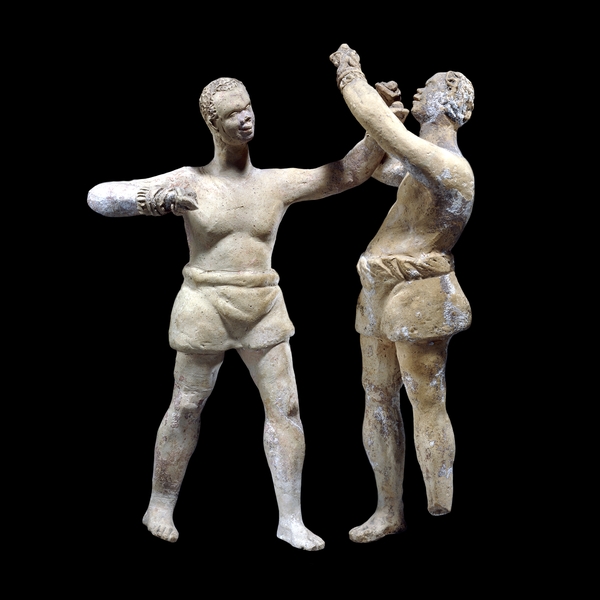
Figure 20. Terracotta figures depicting two African boxers using the caestus, 2nd to 1st century B.C.E.
Source: © The Trustees of the British Museum, used with permission.
|
Two terracotta figures,
now part of The British Museum, dating from the second or first
century B.C.E.,
depict African boxers using caesti (Figure
20). The boxer on the left is delivering a solid uppercut with his
left hand to his opponent's chin, knocking his adversary's head
upward and backward. The sheer violence of that blow is unimaginable
to a modern-day boxer. Outside of these terracotta figures, however,
we have little, if any, hard evidence of boxing in ancient Africa.
The evidence that we do have is mainly from oral traditions, where
various forms of hand-to-hand combat are referenced [EN34]. The Hausa
(the northeast portion of Hausaland, particularly modern Sudan and
Chad, is the area that overlaps Kush that is mentioned in the Old
Testament) compete, today, in Dambe boxing, which has several
characteristics, such as stance, armament, and clothing, which are
interestingly similar to ancient Egyptian, Greek, and Roman boxing
scenes. The Dambe boxers traditionally wear loincloths (warki)
(but they are now beginning to wear shorts), and cover their balled,
dominant hands with a cloth strip (kara).
The kara is secured
to the hand, often with a knotted cord (zare),
and the cloth-and-cord-covered hand is used only for striking and
referred to as a “spear”; the non-dominant hand is called the
“shield,” and is used to parry incoming blows [EN35]. Some Dambe
boxers have been known to add broken glass to their kara,
but, today, the practice is highly discouraged and forbidden in
competition [EN36]. The technique employed by the Dambe boxers seems
eerily similar to the other ancient boxers, especially the act of
using thongs on only one hand and incorporating the other hand as a
defensive weapon [EN37]. While there was much exchange between Africa
and the Mediterranean during antiquity, it is impossible to know if
the these ancient peoples influenced one another with respect to
boxing. According to a leading anthropologist, Dr. Thomas A. Green,
“Wrapping a rope
or leather thong around the hand for fighting isn't a very complex
invention, and polygenesis is as likely an explanation as
cross-cultural borrowing” (personal communication, 14 April 2008).
That said, we do know that boxing was not exclusive to the
Mediterranean; the inhabitants of the African continent, too, were
involved in some form of boxing that utilized hand coverings, even if
only quite rudimentary.
Conclusion
Boxing has a long history
that can be traced back to the infancy of mankind, in the “Cradle
of Civilization” known as Mesopotamia. Ancient artifacts, from
stone tablets to intricate vase paintings reference boxing and the
types of gloves developed and used. The initial boxing “gloves”
were nothing more than long, thin, leather straps, wrapped uniquely
around the wrists and hands to provide anatomical support for one
boxer while exacerbating the pain felt by the other. These “soft
thongs” eventually evolved into “sharp thongs,” simply to
increase the brutality of the sport, and purportedly, to enhance the
entertainment value. The ultimate sense of violence, however, is
attributed to the Romans, who developed a glove called a caestus,
which, from a philosophical standpoint, was little more than a
modern, switch-blade knife.
Notes
1. Crowther, N. B. (2007).
Sport in
Ancient Times.
Westport, Connecticut and London: Praeger. Crowther writes, “A
representation on a clay tablet from a tomb at Sinkara suggests to
some researchers that the Sumerians also boxed with bare fists;
however, others interpret this scene as dancing.” p. 19
2.
Poliakoff, M. B. (1987). Combat
Sports in the Ancient World: Competition, Violence, and Culture.
New Haven: Yale University Press. p. 65.
3. Crowther (above n. 1) states, “The consensus is
that these are indeed boxers, because they are located next to a
combat scene of stick fighters. Other scholars, however, have
suggested that the figures may not be boxers but dancers....” p. 31
4. The Epigraphic Survey in cooperation with The
Department of Antiquities of Egypt. (1980). The
University of Chicago Oriental Institute Publications. Volume 102.
The Tomb of Kheruef: Theban Tomb 192.
Chicago: The Oriental Institute of The University of Chicago. The
document is available for download in portable document format at
http://oi.uchicago.edu/research/pubs/catalog/oip/oip102.html.
5. For further information
about bull-leaping see Marie Brennan's article at
www.strangehorizons.com/2005/ 20050124/bull-leaping-a.shtml
6. Crowther (above n. 1) states, “These last scenes
are so unclear that some identify the figures as wrestlers.” p. 37
7. The Thera Foundation,
“Boxing Boys” - Room Beta 1, South Wall, H: 2.75m / W: 0.94m
http://www.therafoundation.org/akrotiri/buildingbeta/boxingboysroombeta1southwall/view
8. Not all scholars agree that these “boys” are
boxing. Crowther (above n. 1) states, “Although the modern viewer
may see this fresco as a spirited boxing scene that is more
competitive and closer to boxing of today than boxing on Crete, we
should exercise caution and interpret it in the context of the site
where archaeologists discovered it. Researchers believe that it
represents a ritual activity, noting that artists painted it in a
room that probably functioned as a shrine. Whether the boys are
engaged in an adolescent game that simulates a sporting contest for
adults, with possible connections to boxing on Crete, is more
speculative.” p. 39. I respectfully disagree with this
interpretation. It is my opinion that the “Boxing Boys” are
doing just that: boxing.
9. Kaibel, G. (1878).
Epigrammata
Graeca.
Berlin, no. 942.
10.
Sweet, W. E. (1987). Sport
and Recreation in Ancient Greece.
New York: Oxford University Press. p. 71
11. Crowther, N. B.
(1990). The Evidence for Kicking in Greek Boxing. The
American Journal of Philology, 111(2),
176-181.
12.
Poliakoff, M. B. (1987). Combat
Sports in the Ancient World: Competition, Violence, and Culture.
New Haven: Yale University Press. p. 68
13.
Miller, S. G. (2004). Ancient
Greek Athletics.
New Haven: Yale University Press. p. 51
14.
Eustathius, 1324.18 (translation to English from Sweet, W. E.
(1987). Sport
and Recreation in Ancient Greece: A Sourcebook with Translations.
New York and Oxford: Oxford University Press.)
15.
Haffner, C. and Lusitant, D. E. (Executive Producers). (1996).
Blood and
Honor at the First Olympics.
[Motion Picture]. United States: Greystone Communications, Inc.
16.
Frost, K. T. (1906). Greek Boxing. The
Journal of Hellenic Studies,
26, 213-225. Frost writes, “Professional pugilists seem to agree
that fights of the present day in which very light gloves are used
are more severe than if bare fists were allowed: the gloves have not
enough padding to make any appreciable difference, while they prevent
the knuckles from swelling and deadening the blows. This must have
been the case to an even greater extent when strips of leather were
employed.” p. 214
17.
Lucillus, Greek
Anthology
11.75 (translation to English from Sweet, W. E. (1987). Sport
and Recreation in Ancient Greece: A Sourcebook with Translations.
New York and Oxford: Oxford University Press.)
18.
Pausanias, 8.40.4-5; A 38 (translation to English from Sweet, W. E.
(1987). Sport
and Recreation in Ancient Greece: A Sourcebook with Translations.
New York and Oxford: Oxford University Press.)
19.
The pnakration
was essentially a no-holds-barred fight that was extremely popular to
the ancient Greeks
20.
Plato, Laws
8.830B
(translation to English from Sweet, W. E. (1987). Sport
and Recreation in Ancient Greece: A Sourcebook with Translations.
New York and Oxford: Oxford University Press.)
21.
Plato, Laws
8.830B
(translation to English from Sweet, W. E. (1987). Sport
and Recreation in Ancient Greece: A Sourcebook with Translations.
New York and Oxford: Oxford University Press.)
22.
Plutarch, Moralia
825e (translation to English from Sweet, W. E. (1987). Sport
and Recreation in Ancient Greece: A Sourcebook with Translations.
New York and Oxford: Oxford University Press.)
23. Pausanius, 6.23.4
24. Scanlon, T. F. (1982/3). Greek Boxing Gloves:
Terminology and Evolution. Stadion
8-9,
25. Ibid, p. 40
26. Crowther (above n. 1) states, “The Greeks called
both types of coverings [soft and sharp thongs] “ants,” because
they had a tendency to bite, or sting.” p. 69; Poliakoff (above n.
12) writes, “A popular name for boxing thongs both light and
sharp—myrmex—means
“ant.” Ants, then as now, were known for their ability to bite,
and myrmex lends
itself to boxers' gallows humor.” p. 73; Miller writes, “...their
[boxing thongs] nickname was myrmikes (ants) because they stung and
left nicks and abrasions on the boxers.” p. 51.
27. Scanlon, (above n. 24) p. 39.
28. Not all scholars agree
that the caestus
had metal inserts. See Lee, H. M. (1997). The Later Greek Boxing
Glove and the “Roman” Caestus: A centennial reevaluation of
Juthner's 'Uber Antike Turngerathe'. Nikephoros
10, 161-178. Care must be taken here, as the word caestus
is a Latin term that the ancient Romans purportedly used to refer to
boxing gloves in general. I use the term deliberately to refer to a
Roman boxing glove with metal inserts, as many of the figures and
literary references included in this paper, in my opinion, clearly
depict or describe, respectively, metal within the caesti.
29.
Kohne, E. and C. Ewigleben. (2000). Gladiators
and Caesars: The Power of Spectacle in Ancient Rome: Berkeley:
University of California Press.
30.
Haffner, C., Lusitana, D. E. (Executive Producers). (1996).
Blood & Honor at the First Olympics [Motion
Pictures]. United States: Greystone Communicaitons, Inc. We must
assume that Scanlon was discussing Olympic boxing during Roman rule.
Again, however, the evidence for metal inserts in the boxing gloves
is limited, and some scholars believe that the caestus
actually
never had metal inserts (see 28 above).
31.
Virgil, Aeneid
V.404-484
32.
Virgil, Aeneid
V.413
33.
Suetonius, Divus
Augustus, 45
34.
Tremearne, A. J. N. (1910). Fifty Hausa Folk-Tales (Continued).
Folklore,
21(4), 487-503.
35.
Green, T. (2005). Dambe: Traditional Nigerian Boxing. InYo:
Journal of Alternative Perspectives
http://ejmas.com/jalt/2005jalt/jcsart_Green_0905.html
Green states, “This shield and spear aspect is literal rather than
figurative...”
36. Ibid.
37.
See Figure 11, where only the striking hand of Greek boxers is
fitted with a thong; Figure 13 depicts boxers using one hand in an
“open-hand” configuration, probably for defensive tactics.
Our
Sponsor, SDKsupplies














